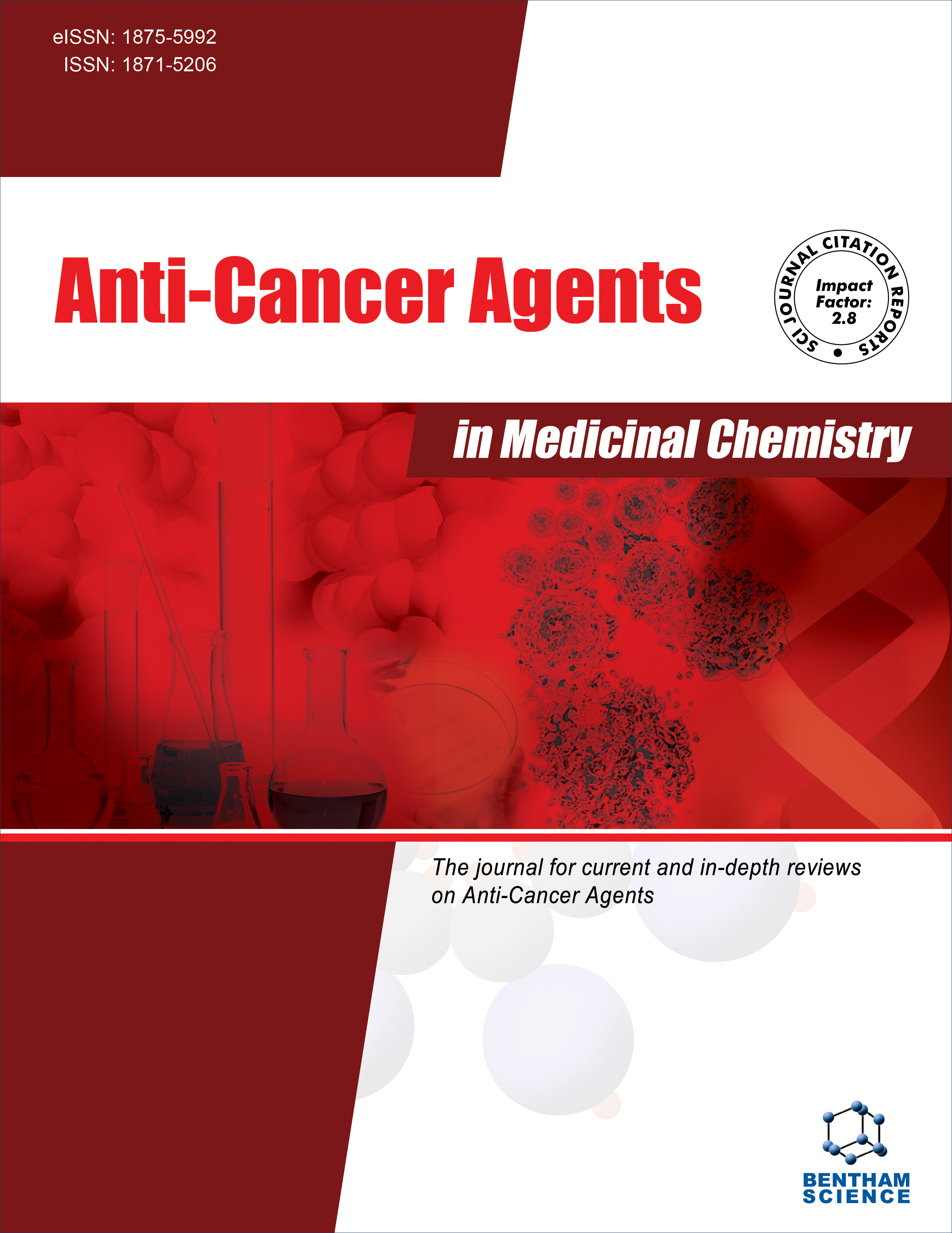- Home
- A-Z Publications
- Anti-Cancer Agents in Medicinal Chemistry (Formerly Current Medicinal Chemistry - Anti-Cancer Agents)
- Previous Issues
- Volume 24, Issue 18, 2024
Anti-Cancer Agents in Medicinal Chemistry (Formerly Current Medicinal Chemistry - Anti-Cancer Agents) - Volume 24, Issue 18, 2024
Volume 24, Issue 18, 2024
- Medicine, Oncology, Drug Design, Discovery and Therapy, Drug Design & Discovery, Chemistry, Medicinal Chemistry, Pharmacology
-
-
-
Application of Nanoparticles in the Diagnosis and Treatment of Colorectal Cancer
More LessAuthors: Qiuyu Song, Yifeng Zheng, Guoqiang Zhong, Shanping Wang, Chengcheng He and Mingsong LiColorectal cancer is a common malignant tumor with high morbidity and mortality rates, imposing a huge burden on both patients and the healthcare system. Traditional treatments such as surgery, chemotherapy and radiotherapy have limitations, so finding more effective diagnostic and therapeutic tools is critical to improving the survival and quality of life of colorectal cancer patients. While current tu Read More
-
-
-
-
Silibinin Induces Both Apoptosis and Necroptosis with Potential Anti-tumor Efficacy in Lung Cancer
More LessAuthors: Guoqing Zhang, Li Wang, Limei Zhao, Fang Yang, Chunhua Lu, Jianhua Yan, Song Zhang, Haiping Wang and Yixiang LiBackground The incidence of lung cancer is steadily on the rise, posing a growing threat to human health. The search for therapeutic drugs from natural active substances and elucidating their mechanism have been the focus of anti-tumor research. Objective Silibinin (SiL) has been shown to be a natural product with a wide range of pharmacological activities, including anti-tumour activity. In our work, SiL was chosen as a pos Read More
-
-
-
The Role of Serine Protease 8 in Mediating Gefitinib Resistance in Non-small Cell Lung Cancer
More LessAuthors: Hai-Jing Gao, Xue-Li Geng, Ling-Ling Wang, Chun-Nan Zhao, Zong-Ying Liang and En-Hong XingObjective This investigation aims to explore the expression levels of serine protease 8 (PRSS8) in gefitinib-resistant Non-Small Cell Lung Cancer (NSCLC) cell lines (PC9/GR) and elucidate its mechanism of action. Methods We measured PRSS8 expression in gefitinib-resistant (PC9/GR) and sensitive (PC9) NSCLC cell lines using Western blot analysis. PRSS8-specific small interfering RNA (PRSS8-siRNA), a recombinant plasmid, Read More
-
-
-
Molecular Imaging of Melanoma VEGF-expressing Tumors through [99mTc]Tc-HYNIC-Fab(Bevacizumab)
More LessBackground Angiogenesis is a process that many tumors depend on for growth, development, and metastasis. Vascular endothelial growth factor (VEGF) is one of the major players in tumor angiogenesis in several tumor types, including melanoma. VEGF inhibition is achieved by bevacizumab, a humanized monoclonal antibody that binds with high affinity to VEGF and prevents its function. In order to successfully enable in vivo V Read More
-
-
-
Cyclanoline Reverses Cisplatin Resistance in Bladder Cancer Cells by Inhibiting the JAK2/STAT3 Pathway
More LessAuthors: Linjin Li, Chengpeng Li, Feilong Miao, Wu Chen, Xianghui Kong, Ruxian Ye and Feng WangBackground Cisplatin is a key therapeutic agent for bladder cancer, yet the emergence of cisplatin resistance presents a significant clinical challenge. Objective This study aims to investigate the potential and mechanisms of cyclanoline (Cyc) in overcoming cisplatin resistance. Methods Cisplatin-resistant T24 and BIU-87 cell models (T24/DR and BIU-87/DR) were established by increasing gradual concentration. Western Bl Read More
-
-
-
Agrimonolide Inhibits the Malignant Progression of Non-small Cell Lung Cancer and Induces Ferroptosis through the mTOR Signaling Pathway
More LessAuthors: Xiaoling Zhang, Wei Cai and Yiguang YanBackground Non-Small Cell Lung Cancer (NSCLC), a prevalent type of lung cancer, has a poor prognosis and contributes to a high mortality rate. Agrimonolide, which belongs to the Rosaceae family, possesses various biomedical activities. This study aimed to explore the efficacy and mechanism of agrimonolide in NSCLC. Methods The viability, proliferation, and tumor-forming ability of A549 cells were detected using t Read More
-
Volumes & issues
-
Volume 25 (2025)
-
Volume 24 (2024)
-
Volume 23 (2023)
-
Volume 22 (2022)
-
Volume 21 (2021)
-
Volume 20 (2020)
-
Volume 19 (2019)
-
Volume 18 (2018)
-
Volume 17 (2017)
-
Volume 16 (2016)
-
Volume 15 (2015)
-
Volume 14 (2014)
-
Volume 13 (2013)
-
Volume 12 (2012)
-
Volume 11 (2011)
-
Volume 10 (2010)
-
Volume 9 (2009)
-
Volume 8 (2008)
-
Volume 7 (2007)
-
Volume 6 (2006)
Most Read This Month
Article
content/journals/acamc
Journal
10
5
false
en


